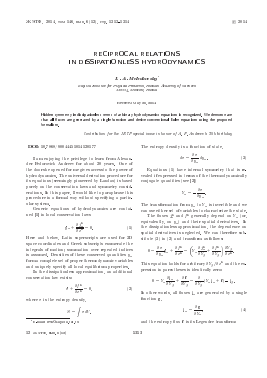>K9m 2014, TOM 146, Bbin. 6 (12), erp. 1313 1314 © 2014
RECIPROCAL RELATIONS IN DISSIPATION LESS HYDRODYNAMICS
L. A. Melnikovsky*
Kapitza Institute for Physical Problems, Russian Academy of Sciences 119334, Moscow, Russia
Received May 26, 2014
Hidden symmetry in dissipationless terms of arbitrary hydrodynamics equations is recognized. We demonstrate that all fluxes are generated by a single function and derive conventional Euler equations using the proposed formalism.
Contribution for the JETP special issue in honor of A. F. Andreev's 75th birthday
DOI: 10.7868/S0044451014120177
The entropy density is a function of state,
I am enjoying the privilege to learn from Alexander Fedorovich Andreev for about 20 years. One of the doors he opened for me gives access to the power of hydrodynamics. The universal derivation procedure for its equations (seemingly pioneered by Landau) is based purely 011 the conservation laws and symmetry considerations. In this paper, I would like to paraphrase this procedure in a formal way without specifying a particular system.
Generic equations of hydrodynamics are contained [11 in local conservation laws
dik
(i)
Here and below, Latin superscripts are used for 3D space coordinates and Greek subscripts enumerate the integrals of motion; summation over repeated indices is assumed. Densities of these conserved quantities ya form a complete set of proper thermodynamic variables and uniquely specify all local equilibrium properties.
In the dissipationless approximation, an additional conservation law exists:
dxk
= 0.
(2)
where a is the entropy density,
5 = / a dV.
E-mail: leva'ökapitza.ras.ru
; 9(7 , (h7 = -— dya
OïJa
(3)
Equations (1) have internal symmetry that is revealed if expressed in terms of the thermodynamically conjugate quantities (see [2])
i; =
da d'Ja
The transformation from ya to Ya is invertible and we can use either set of variables to characterize the state.
The fluxes jk and fk generally depend 011 Ya (or, equivalently, 011 ya) and their spatial derivatives. In the dissipationless approximation, the dependence 011 spatial derivatives is neglected. We can therefore substitute (3) in (2) and transform as follows:
n 9(7 ■
0 = ~-!J a
OïJa
3/* dxk
= 1
M
dfk
dYfi
dY¿ dxk '
This equation holds for arbitrary dY^/dxk and the expression in parentheses is identically zero:
0 = i;
djq
at
dYfi
d 31
n
(>'aja + f) - ifi-
la other words, all fluxes jQ are generated by a single function g,
Ja —
OY,
(4)
and the entropy flux f is its Legendre transform:
12 >K9T<£>, iibiii.6(12)
1313
L. A. Melnikovsky
>K3TO, TOM 146, Bbin.6(12), 2014
f = g
^ajo
(5)
This coniplotos the proof that the matrix of derivatives dja/dYft is symmetric,
djg
dYfi
djß dYn
(6)
in agreement1^ with Onsagcr's principle [3].
The proof does not rely upon any specific property of the entropy itself. In fact, Eq. (2) is just one of local conservation laws and "thcrniodynaniically conjugate quantities" Ya could have been defined with respect to any other integral of motion. In practice, it might be more convenient to use energy rather than entropy for this.
To illustrate this formalism, we consider a classical ideal fluid. Energy per unit volume E is a function of other conserved quantities:
dE = T da ■
fi
— ) dp + Viij,
where // is the chemical potential, p is the IIlclSS density, v is the fluid velocity, and j is the momentum density. The conjugate variables are therefore
Ya = —T, Yp = v2/2 — //., >j = —v.
Due to the fluid isotropy, the generating function is
g = vh(T,Yp,v), where the scalar h can be obtained from the identity
JP = J = pv-
pv =
dY,
= —v
dh\ dp J,
lP / T,v / T,v
Recalling the expression for the pressure differential
dp = a (IT + pdfi,
we obtain h = —p. It can be easily verified that the function g = —pv generates conventional Euler fluxes:
/ 1P1*3
TTik _ -i _ I
- Jik - gy.k J
.Vljk J Y Y
= p6ik + ßViVk.
REFERENCES
1. L. D. Landau and E. M. Lifsliitz. Fluid Mechanics, Porgamon Press, Oxford (1987).
2. L. D. Landau and E. M. Lifsliitz, Statistical Physics, part 1, Porgamon Press, Oxford (1980).
3. L. Onsager, Pliys. Rev. 37, 405 (1931).
11 Macroscopic reversibility implies that ami (or yn) behave oppositely under time reversal.
Для дальнейшего прочтения статьи необходимо приобрести полный текст. Статьи высылаются в формате PDF на указанную при оплате почту. Время доставки составляет менее 10 минут. Стоимость одной статьи — 150 рублей.
